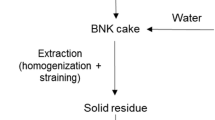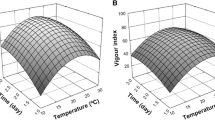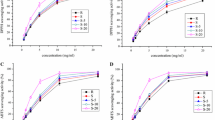Abstract
The roasting process and color development have been related to an increase of the antioxidant activity of roasted malts. However, roasting is also responsible for the development of high molecular compounds with a pro-oxidant effect, leading to increased levels of radicals in systems based on iron- and copper-catalyzed Fenton reactions. For this reason, the overall antioxidant and pro-oxidant properties of three malt types with different roasting degrees (pilsner, melano and black) were evaluated in a Fenton-based model beer system (5.8 % ethanol, v/v). Black malt exhibited 50 % lower radical quenching capacity compared with pale and melano malts, as determined by spin trapping and electron spin resonance detection. These differences were related to the degree of roasting and the development of high molecular weight browning compounds. High molecular weight compounds isolated from black malt wort (molecular mass in the range of 4 × 106 and 108 g mol−1) were responsible for an increase of radicals (approximately 40 %) in a Fenton reaction and were able to accelerate metal-catalyzed oxidation in a beer model, as shown by a decrease of almost 11 % of the dissolved oxygen. Although black malt was able to reduce the overall levels of radicals generated by the Fenton reaction, high molecular weight compounds had an opposite effect due to the reductive redox-cycling of the catalytic amounts of iron.





Similar content being viewed by others
Abbreviations
- ESR:
-
Electron spin resonance
- HMW:
-
High molecular weight
- LMW:
-
Low molecular weight
- MLD:
-
Melanoidins
- MRPs:
-
Maillard reaction products
- PBN:
-
N-tert-Butyl-α-phenylnitrone
- ROS:
-
Reactive oxygen species
- SEC:
-
Size-exclusion chromatography
- TEMPO:
-
2,2,6,6-Tetramethylpiperidine 1-oxyl
References
Coghe S, Gheeraert B, Michiels A, Delvaux FR (2006) Development of Maillard reaction related characteristics during malt roasting. J Inst Brew 112(2):148–156
Coghe S, D’Hollander H, Verachtert H, Delvaux FR (2005) Impact of dark specialty malts on extract composition and wort fermentation. J Inst Brew 111(1):51–60
Coghe S, Adriaenssens B, Leonard S, Delvaux FR (2004) Fractionation of colored Maillard reaction products from dark specialty malts. J Am Soc Brew Chem 62(2):79–86
Yahya H, Linforth RST, Cook DJ (2014) Flavour generation during commercial barley and malt roasting operations: a time course study. Food Chem 145:378–387
Wang H-Y, Qian H, Yao W-R (2011) Melanoidins produced by the Maillard reaction: structure and biological activity. Food Chem 128(3):573–584
Carvalho DO, Correia E, Lopes L, Guido LF (2014) Further insights into the role of melanoidins on the antioxidant potential of barley malt. Food Chem 160:127–133
Magalhães PJ, Almeida SM, Carvalho AM, Gonçalves LM, Pacheco JG, Cruz JM, Guido LF, Barros AA (2011) Influence of malt on the xanthohumol and isoxanthohumol behavior in pale and dark beers: a micro-scale approach. Food Res Int 44(1):351–359
Wunderlich S, Zürcher A, Back W (2012) Xanthohumol in brewing-impact of malt, xanthohumol dosage, wort and storage temperature. Brewing Sci 65(1–2):7–15
Pastoriza S, Rufián-Henares JA (2014) Contribution of melanoidins to the antioxidant capacity of the Spanish diet. Food Chem 164:438–445
Langner E, Rzeski W (2014) Biological properties of melanoidins: a review. Int J Food Prop 17(2):344–353
Samaras TS, Camburn PA, Chandra SX, Gordon MH, Ames JM (2005) Antioxidant properties of kilned and roasted malts. J Agric Food Chem 53(20):8068–8074
Echavarría AP, Pagán J, Ibarz A (2012) melanoidins formed by Maillard reaction in food and their biological activity. Food Eng Rev 4(4):203–223
Coghe S, Adriaenssens B, Leonard S, Delvaux FR (2003) Characterization of dark specialty malts: new insights in color evaluation and pro- and antioxidative activity. J Am Soc Brew Chem 61(3):125–132
Hoff S, Lund MN, Petersen MA, Jespersen BM, Andersen ML (2012) Influence of malt roasting on the oxidative stability of sweet wort. J Agric Food Chem 60(22):5652–5659
Kunz T, Strähmel A, Cortés N, Kroh LW, Methner FJ (2013) Influence of intermediate maillard reaction products with enediol structure on the oxidative stability of beverages. J Am Soc Brew Chem 71(3):114–123
Vanderhaegen B, Neven H, Verachtert H, Derdelinckx G (2006) The chemistry of beer aging—a critical review. Food Chem 95(3):357–381
Guido LF, Fortunato NA, Rodrigues JA, Barros AA (2003) Voltammetric assay for the aging of beer. J Agric Food Chem 51(14):3911–3915
Andersen ML, Skibsted LH (1998) Electron spin resonance spin trapping identification of radicals formed during aerobic forced aging of beer. J Agric Food Chem 46(4):1272–1275
Andersen ML, Outtrup H, Skibsted LH (2000) Potential antioxidants in beer assessed by ESR spin trapping. J Agric Food Chem 48(8):3106–3111
Morales FJ (2005) Assessing the non-specific hydroxyl radical scavenging properties of melanoidins in a Fenton-type reaction system. Anal Chim Acta 534(1):171–176
Nøddekær TV, Andersen ML (2007) Effects of Maillard and caramelization products on oxidative reactions in lager beer. J Am Soc Brew Chem 65(1):15–20
EBC (2003) Analytica EBC. Fachverlag Hans Carl, Nürnberg
Rødtjer A, Skibsted LH, Andersen ML (2006) Antioxidative and prooxidative effects of extracts made from cherry liqueur pomace. Food Chem 99(1):6–14
Nelson DP, Kiesow LA (1972) Enthalpy of decomposition of hydrogen peroxide by catalase at 25 degrees C (with molar extinction coefficients of H2O2 solutions in the UV). Anal Biochem 49(2):474–478
Nunes CA, Alvarenga VO, de Souza Sant’Ana A, Santos JS, Granato D (2015) The use of statistical software in food science and technology: advantages, limitations and misuses. Food Res Int 75:270–280
Cämmerer B, Chodakowski K, Gienapp C, Wohak L, Hartwig A, Kroh L (2012) Pro-oxidative effects of melanoidin–copper complexes on isolated and cellular DNA. Eur Food Res Technol 234(4):663–670
Čechovská L, Konečný M, Velíšek J, Cejpek K (2012) Effect of maillard reaction on reducing power of malts and beers. Czech J Food Sci 30(6):548–556
Jehle D, Lund MN, Øgendal LH, Andersen ML (2011) Characterisation of a stable radical from dark roasted malt in wort and beer. Food Chem 125(2):380–387
Cortes N, Kunz T, Suarez AF, Hughes P, Methner FJ (2010) Development and correlation between the organic radical concentration in different malt types and oxidative beer stability. J Am Soc Brew Chem 68(2):107–113
Danilewicz JC (2013) Reactions involving iron in mediating catechol oxidation in model wine. Am J Enol Viticult 64(3):316–324
Acknowledgments
This work was funded by FEDER through the Operational Programme for Competitiveness Factors—COMPETE and by National Funds through FCT—Foundation for Science and Technology under the projects UID/QUI/50006/2013 and NORTE-07-0124-FEDER-000069. DC wishes to acknowledge FCT for his PhD studentship (SFRH/BD/79939/2011).
Author information
Authors and Affiliations
Corresponding author
Ethics declarations
Conflict of interest
The authors declare that they have no conflict of interest.
Compliance with ethics requirements
This article does not contain any studies with human or animal subjects.
Rights and permissions
About this article
Cite this article
Carvalho, D.O., Øgendal, L.H., Andersen, M.L. et al. High molecular weight compounds generated by roasting barley malt are pro-oxidants in metal-catalyzed oxidations. Eur Food Res Technol 242, 1545–1553 (2016). https://doi.org/10.1007/s00217-016-2655-7
Received:
Revised:
Accepted:
Published:
Issue Date:
DOI: https://doi.org/10.1007/s00217-016-2655-7




